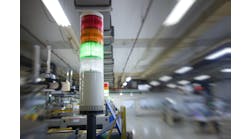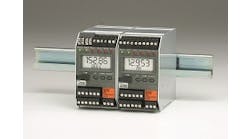- How are end users implementing stack lights on multi-station assembly lines?
- Why are operator buttons needed if an HMI can provide the same function?
- How can stack lights improve machine or system productivity?
- How do I indicate and describe alarms without overloading an operator with too much information?
Why are we still using stack lights, annunciators and push buttons? Are machine designers going for a retro look with these antiquated analog components? Or maybe it’s the hipster in them, wanting to show that they were building machines with interface devices before interface was cool. “That annunciator sounded way better on vinyl.”
Human-machine interface (HMI) can offer a digital version of almost any button, knob or light, but analog still has its place on machines, whether it’s for its ruggedness, for no-look interaction or for situations in which touchscreen operation isn’t an option.
We posed several questions regarding these time-tested components to a panel of industry veterans to see what light their experience and expertise might shed on the subject.
What are some of the best ways to indicate alarms and confirm that appropriate operator action has occurred?
Starting with the human factor, how well and how fast do the operators perceive the environment? What is the thought process, from the visual or acoustic detection of an event to the decision?
With high performance HMI/SCADA, visualization is all about improved situational awareness. Situational awareness is the ability to identify, process and comprehend the critical elements of information about what is happening. More simply, it’s knowing what is going on around you.
Well-designed, standardized HMIs and alarm-management systems are key to delivering the user experience required to make the right decisions and positively impact performance. We can deliver seamless, context-driven, intelligent information, based on each user’s role.
Our Industrial-Internet-of-Things (IIoT) world helps us to send alarms in context. This means, once an alarm fires, an operator should be able to understand contextually not just where the issue is occurring, but more directly where and when there is an issue occurring in the processes they manage.
Operators need to be able to understand the corrective action required to resolve an alarm. As such, seeing that alarm in context is important. In the past, operations teams relied on years of experience for that context—the so-called “machine whisperer” who understood that if “x alarm” occurred under “y circumstances,” then it meant a conveyor, for example, was moving too fast, and they knew exactly how to tweak a dial. With our changing workforce, those days are gone, and digitization must be the foundation for providing the context to newer, inexperienced workers.
HMI/SCADA today takes operators beyond alarm acknowledgement to driving the right corrective action. With a guided and consistent event response, OEMs can reduce troubleshooting time and midnight emergency phone calls.
Tracking and reporting on work processes with work-flow technology embedded in the HMI/SCADA allows companies to identify and eliminate nuisance events, compare operator performance and evaluate opportunities for improvement. Additionally, a digital log entry reduces labor and increases the information collected on events—no more lost sheets of paper.
Alicia Bowers is product marketing manager, automation software, at GE Digital.
Zach Tinkler is U.S. product manager, control and signaling at Schneider Electric.
Matt Newton is director of technical marketing at Opto 22.
Thomas Putz is sales manager at Auer Signal.
Many modern HMIs have dedicated event-logging capability with the capacity to email reports on command or schedules that include alarm logs with machine variables at the time of the alarm. The logs can include operator acknowledgement status of the alarm. The value of logged data is long-term analysis of machine performance by technicians and engineers. The alarm event data, over time, may be used to reveal areas for improvement in the equipment, tooling issues or maintenance intervals.
Lee Clore is owner/controls designer at Onyx Industries.
We have technology for implementing alarm management, too, and developing the HMI graphics for the alarm, moving to HTML5 next.
John Kowal, director, business development, B&R Industrial Automation.
Don King is product manager at Rockwell Automation.
Ways to indicate alarms with push buttons and stack lights are pretty simple. This is where you would use illuminated push buttons and pilot lights for indication of alarms. An active alarm condition can be indicated by a flashing red or amber light to draw attention, or it can be steady state. Once the alarm condition is corrected, the red or amber light turns off. Green indication is typically used to identify normal operation, while blue, clear or white is used for confirmation commands or indicating action is needed. The use of multi-color LED indicators are ideal for these applications.
Push buttons and stack lights are great for binary alarm indication, but sometimes more information is needed; this is where an HMI comes in handy. A best practice for alarms with HMI screens is to place the alarm banner across the top of the screen and have it available on all screens along with a button that can provide more detail.
Michael Day is industrial control products market development manager at Siemens.
Sopan Khurana is applications engineer at Patlite.
Robb Weidemann is senior business development manager at Banner Engineering.
Another nice feature of configurable LED stack lights is in a traditional stack-light operation: If a flashing single segment is not acknowledged within a certain time period, such as 45 seconds, the entire stack light begins to flash red. If it is not acknowledged after an additional time period, say 2 minutes, the buzzer is activated.
Will Healy III is marketing management director at Balluff.
Michael O’Neill is president at Werma-USA.
ALSO READ: Harsh environments call for more rugged components
Mike Bacidore is the editor in chief for Control Design magazine. He is an award-winning columnist, earning a Gold Regional Award and a Silver National Award from the American Society of Business Publication Editors. Email him at [email protected].


















